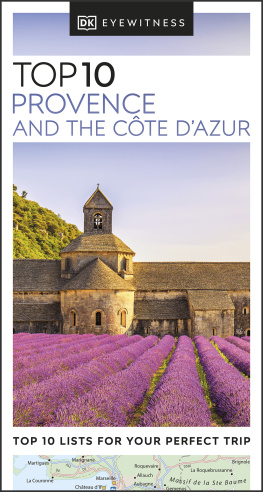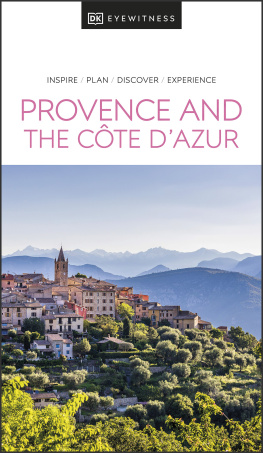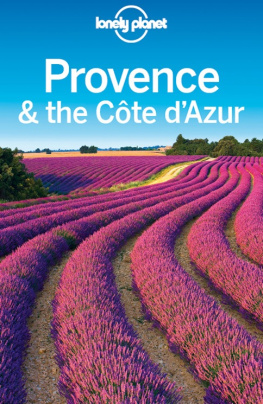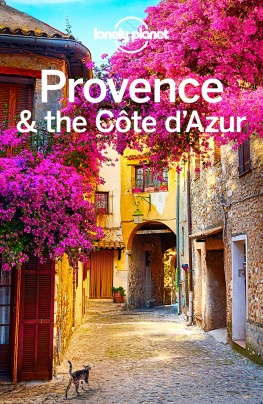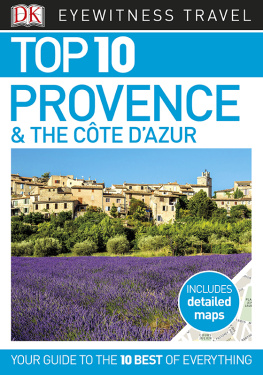

First published in the United States of America in 2015 by Chronicle Books LLC.
First published in Australia in 2013 by Plum, an imprint of Pan Macmillan Australia.
Copyright 2013 by Janelle McCulloch.
All rights reserved. No part of this book may be reproduced in any form without written permission from the publisher.
Library of Congress Cataloging-in-Publication Data available.
ISBN 978-1-4521-4051-3 (pb)
ISBN 978-1-4521-4874-8 (epub, mobi)
Design by Michelle Mackintosh
Edited by Miriam Cannell
Proofread by Margaret Barca
Index by Jo Rudd Additional photography credits: : David Martyn / Dreamstime.
Chronicle Books LLC
680 Second Street
San Francisco, California 94107
www.chroniclebooks.com

CONTENTS
PART ONE:
PROVENCE
LIsle-sur-la-Sorgue:
The Antiques Lover
Mnerbes:
The Reluctant Star
Lourmarin:
The Gourmet Lover
Saint-Rmy-de-Provence:
The Aesthete
Aix-en-Provence:
The Elegant Beauty
Avignon:
The Arts Lover
Arles:
The Historical Beauty
Uzs:
The Hideaway
PART TWO:
THE CTE DAZUR
Nice:
The Grande Dame
Cap Ferrat:
The Aristocrat
Beaulieu-sur-Mer:
The Secret Delight
ze:
The Escapist
Menton:
The Garden Lover
Saint-Paul-de-Vence:
The Artist
Cannes:
The Film Star
Antibes and Cap dAntibes:
The Lit Wit
Juan-les-Pins:
The Beach Beauty
Saint-Tropez:
The Glamour Puss
PART THREE:
DIRECTORY OF INSPIRing PLACES
Note: Apologies to French speakers and Francophiles, but weve decided to follow the English convention of capitalizing street names, geographical place names, days of the week, etc. Thus, Place du Gnral de Gaulle (not place du Gnral de Gaulle), Baie des Anges (not baie des Anges), and Gare de Nice Ville (not gare de Nice Ville).


DISCOVERING THE SPIRIT OF THE SOUTH OF FRANCE
The South of France is the stuff of travel hyperbole. The region may not have invented the word glamour, but it has certainly adopted it as its mission statement. This famous part of the Mediterranean coast is a glorious, almost painterly swirl of spectacular, sun-filled landscapes, seductive villages, sublime beaches, secret coves, scented gardens, high-octane cars, beautiful people, and a blissful climate.
Adding further interest is the fact that there are two sides to the South of France. There is the coast, an area that encompasses the Riviera, with its charming coves, bobbing yachts, Belle poque architecture, bougainvillea-draped lanes, grand villas, and waterfront promenades buoyant with life.
And there is the countryside, an area that includes Provencea gentle and charmingly photogenic scene of winding roads, weekend markets, sleepy villages, Roman ruins, enchanting chteaux, fields of lavender and sunflowers, babbling fountains, and dapper gentlemen chatting or playing boules in ancient squares, all enveloped in a light that seems almost Impressionist in quality.

SAY HELLO TO PROVENCE AND THE CTE DAZUR

Now something needs to be clarified before we tie our hair in a silk Herms scarf and start our sky-blue Sunbeam convertibles. The terms Cte dAzur, Provence, and the French Riviera are not so much strictly defined geographical areas as they are states of mind: each a shift in spirit that happens once you get past a certain point on the road from Paris to Nice. The official name for this region is Provence-AlpesCte dAzur. But as thats a bit of a mouthful, shorter phrases have crept into the vernacular. Some people like to use Cte dAzur or the French Riviera if theyre visiting the Mediterranean coastline along the southeast corner of France, or theyll say Provence if theyre visiting the hinterland and countryside further inland. Other people see the entire southeastern corner of France as Provence. Its complicated, I know.
To be precise, this region comprises six major dpartements. However, for the purposes of this book we have decided to simply split the region into two areas: Provence and the Cte dAzur. Easy.
Thats the admin done; now for the short history and glamorous anecdotes. Like much of Europe, the history of this part of France is long and complicated. It begins 40,000 years ago with prehistoric settlements, Greek colonies in 600 BC, Roman influence from around the third century BC, endless barbarian invasions, and the incredible fortifications of the medieval period that form the core of many of the regions breathtakingly beautiful villages. Unfortunately, space does not permit me to delve deeply into such a complex past, but I will attempt to offer some insights into the history of each town as we go.
For now, let us focus on the more recent legends who have passed through this area: F. Scott and Zelda Fitzgerald in Juan-les-Pins; Picasso and Graham Greene in Antibes; Matisse in Nice; Batrice de Rothschild, David Niven, and Somerset Maugham in Cap Ferrat; Cocteau and Chanel in Menton, and Bardot in Saint-Tropez. They came for the garden parties, the soires, the people, and the experiences theyd later immortalize in print or with paint and canvas. They came for the sun and fun, the decadence and indiscretions, the swimming coves and beaches, and all the sights in between.
Yet it wasnt always like this. The South of France only really became popular at the end of the eighteenth century when the British and northern European upper classes saw its potential as a winter resort. When the new railway arrived in the mid-19th century, the area rapidly became the playground of the European well-to-do and, soon after, the wealthy American set. And it is still one of the most popular places in the world for stars to escape to. Elton John loves it so much that he bought a home in the hills above Nice. Bono has one on the beach at ze-Bord-de-Mer. Sting and his family like to come here and hang out each year, as do Naomi Campbell, Kate Moss, and Giorgio Armani. And Jack Nicholson often cavorts here, although its usually on a yacht with a few beautiful models. Some days, particularly in May during the Cannes Film Festival, half of Hollywood seems to have decamped to the Riviera.
The South of France does, however, have a flip side. Overdevelopment has ruined some of the beautiful coastline, and in the height of summer the roads are often jammed with cars. Even in Provence, the lines of summer tourists can become an eyesore on the lavender-etched landscape. But you can still find old Provence and the classic Riviera in many places: the coastal paths around Cap Ferrat and Cap dAntibes, the pretty side streets of Cannes and Nice, and, of course, the back roads of Provence.
Next page


